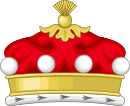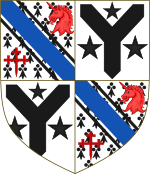
Duke of Devonshire is a title in the Peerage of England held by members of the Cavendish family. This branch of the Cavendish family has been one of the wealthiest British aristocratic families since the 16th century and has been rivalled in political influence perhaps only by the Marquesses of Salisbury and the Earls of Derby.

Earl of Lichfield is a title that has been created three times, twice in the Peerage of England and once in the Peerage of the United Kingdom (1831). The third creation is extant and is held by a member of the Anson family.

Marquess Conyngham, of the County of Donegal, is a title in the Peerage of Ireland. It was created in 1816 for Henry Conyngham, 1st Earl Conyngham. He was the great-nephew of another Henry Conyngham, 1st Earl Conyngham, a member of a family of Scottish descent which had settled during the Plantation of Ulster in County Donegal in Ireland in the early 17th century. The 'founder' of the dynasty in Ireland was The Very Rev. Dr. Alexander Cunningham, Dean of Raphoe. The earlier Henry was a member of both the Irish House of Commons and the British House of Commons and served as Vice-Admiral of Ulster and as Governor of the counties of Donegal and Londonderry. In 1753 he was raised to the Peerage of Ireland as Baron Conyngham, of Mount Charles in the County of Donegal, and in 1756 he was created Viscount Conyngham, in Ireland, also in the Peerage of Ireland. In 1781 he was made Baron Conyngham, of Mount Charles in the County of Donegal, with remainder to his nephew Francis Burton, and Earl Conyngham, of Mount Charles in the County of Donegal, which like the creations of 1753 and 1756 was created with normal remainder to the heirs male of his body. The latter titles were also in the Peerage of Ireland. Lord Conyngham was childless and on his death in 1781 the barony of 1753, the viscountcy and earldom became extinct while he was succeeded in the barony of 1781 according to the special remainder by his aforementioned nephew Francis. He was the eldest son of Mary, sister of the first Earl Conyngham, by her husband Francis Burton. The new 2nd Baron Conyngham, who had earlier represented Killybegs and County Clare in the Irish House of Commons, assumed by Royal licence the surname and arms of Conyngham on succeeding to the titles.

Earl of Powis (Powys) is a title that has been created three times. The first creation came in the Peerage of England in 1674 in favour of William Herbert, 3rd Baron Powis, a descendant of William Herbert, 1st Earl of Pembroke. In 1687, he was further honoured when he was made Marquess of Powis.

The Mountbatten family is a British dynasty that originated as a British branch of the German princely Battenberg family. The name was adopted on 14 July 1917, three days before the British royal family changed its name from "Saxe-Coburg and Gotha" to "Windsor", by members of the Battenberg family residing in the United Kingdom, due to rising anti-German sentiment among the British public during World War I. The name is a direct Anglicisation of the German Battenberg, or Batten mountain, the name of a small town in Hesse. The titles of count and later prince of Battenberg had been granted in the mid-19th century to a morganatic branch of the House of Hesse-Darmstadt, itself a cadet branch of the House of Hesse.
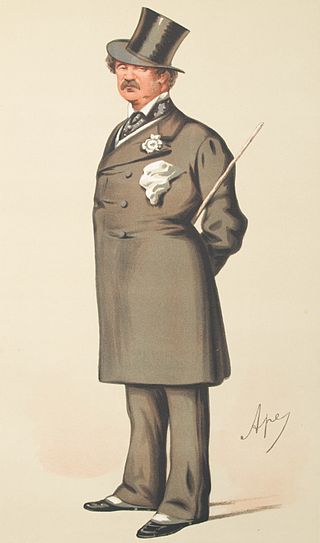
Lord Alfred Henry Paget was a British soldier, courtier and Liberal politician who sat in the House of Commons between 1837 and 1865.
Henry Burton Conyngham, 1st Marquess Conyngham,, known as The Lord Conyngham between 1787 and 1789, as The Viscount Conyngham between 1789 and 1797 and as The Earl Conyngham between 1797 and 1815, was an Anglo-Irish courtier and politician of the Regency period. He served as Lord Steward between 1821 and 1830.

Major Henry Somerset, 7th Duke of Beaufort, KG, styled Earl of Glamorgan until 1803 and Marquess of Worcester between 1803 and 1835, was a British peer, soldier, and politician.
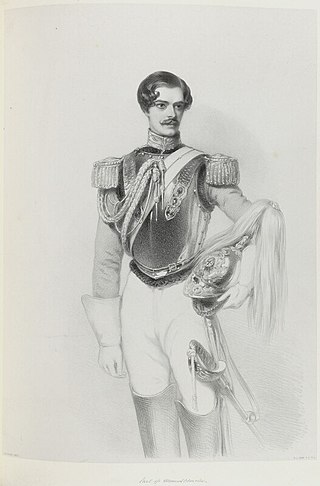
Francis Nathaniel Conyngham, 2nd Marquess Conyngham, KP, GCH, PC, styled Lord Francis Conyngham between 1816 and 1824 and Earl of Mount Charles between 1824 and 1832, was an Anglo-Irish soldier, courtier, politician and absentee landlord.

George Gordon, 9th Marquess of Huntly,, styled Lord Strathavon until 1795 and known as The Earl of Aboyne from 1795 to 1836, was a Scottish peer and soldier.

Francis Almeric Spencer, 1st Baron Churchill DCL FRS was a British peer and Whig politician from the Spencer family.

Albert Denison Denison, 1st Baron Londesborough, KCH, FRS, FSA was a British Whig Party politician and diplomat, known as Lord Albert Conyngham from 1816 to 1849.

William Henry Forester Denison, 1st Earl of Londesborough, known as The Lord Londesborough from 1860 to 1887, was a British peer and Liberal politician. He was also one of the main founders of Scarborough FC.

Elizabeth Conyngham, Marchioness Conyngham, was an English courtier and noblewoman. She was the last mistress of George IV of the United Kingdom.

Major-General Ivor John Caradoc Herbert, 1st Baron Treowen, CB, CMG, KStJ, known as Sir Ivor Herbert, Bt, between 1907 and 1917, was a British Liberal politician and British Army officer in the Grenadier Guards, who served as General Officer Commanding the Militia of Canada from 1890 to 1895. He was made a baronet in 1907 and raised to a barony in 1917.
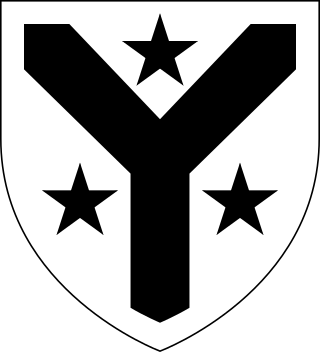
Henry Vivien Pierpont Conyngham, 8th Marquess Conyngham, styled as Viscount Slane until 1974 and as Earl of Mount Charles from 1974 until 2009 and predominantly known as Lord Mount Charles, is an Anglo-Irish aristocrat who is best known for the rock concerts that he organises at his home Slane Castle, and for his column in the Irish Daily Mirror under the byline "Lord Henry".
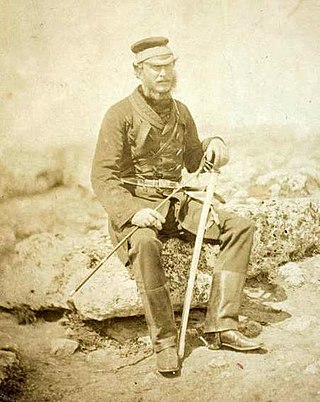
Colonel Francis William Henry Fane, 12th Earl of Westmorland CB, DL, styled Lord Burghersh between 1851 and 1859, was a British Army Officer and racehorse owner.

George Henry Conyngham, 3rd Marquess Conyngham, styled Earl of Mount Charles from 1832 to 1876, was a British peer and soldier.
Vice-Admiral the Hon. Charles Orlando Bridgeman was a Royal Navy officer who saw active service in the Napoleonic Wars and the Greek War of Independence.
John Gaspard Le Marchant Romilly, 3rd Baron Romilly was a British hereditary peer and soldier.
